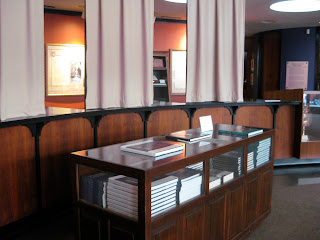 Mother Mary and Benedict Flaget: A Local History
Mother Mary and Benedict Flaget: A Local HistoryOne of the interesting places in Louisville that we discovered in June was the museum of the Archdiocese of Louisville. It was a museum rich with artifacts, statuary, and yes, of course, books. One of the primary highlights of the museum was that of Benedict Joseph Flaget (1763-1850), who had been Bishop of Bardstown and later the Bishop of Louisville. Flaget spent the first part of his life in France, where he was born. He'd taught theology at the University of Nantes for a few years, before the French Revolution. It wasn't until ~1792 that he came to this country, and landed in Baltimore. He moved around a bit among American cities, including Pittsburgh, and over the next thirty years, he moved westward into the burgeoning new country. His travels, ministry, and teaching brought him to Havana, Cuba for a spell, as well as back to France, but he ended up remaining in the United States until his death in 1850.


Images of the museum above. Below is one of several portraits of Bishop Flaget.


One of the most interesting, even stunning discoveries on this visit, was the rare book collection. It was, if I understood correctly, the collection of the Bishop himself! It is an impressive number of rare books, and numbered well into the thousands.

These books, as one of the priests showed us, are housed in an iron vault. The space used to be a bank, and the doors are extremely thick. You can see this in one of the upcoming photos below.


Another portrait of Flaget above. The iron doors below.


The imprint and signiture of Flaget above in one of his books. Another of Flaget's books below (though this appears to be about Flaget).


Above is a lock of Flaget's hair, collected at his death in 1850. Below, is a "host" press--you can see that the waffly communion waffers could be pressed with the image of the crucified Christ, 4 at a time!

We end here with a display case showing off a "monstrance." A monstrance (lit. "to show" or "display") is meant to show off clearly the eucharist. In medieval times, these monstrances held relics. And for those who have traveled to Italy, especially in the south, it is not uncommon to see some monstrances holding such relics. In fact, there is one case, in Lanciano, Italy, (often called the "Miracle of Lanciano"), where the eucharistic host turned into human flesh and the wine into gobules of blood! Nonetheless, these monstrances have played important roles in liturgy and ritual display. Admittedly, this "sociology of religious blood" is a facinating thing, which continues to be part of the cultural design of the human-divine Christologies inhabiting our world and thinking. Perhaps it works, because humans can feel closer to a god/God that has some sort of physical similarity to them, and one who is capable of understanding human suffering? Whatever it is, visiting this small museum will get you thinking about lots of good stuff! We won't worry about bleeding eucharists, though.

The caption in the fourth photo incorrectly identifies the portrait as that of Bishop Flaget, but is actually Bishop John Baptist Mary David, S.S. Further down in the article a portrait of Bishop Flaget is correctly identified. Thank you.
ReplyDelete